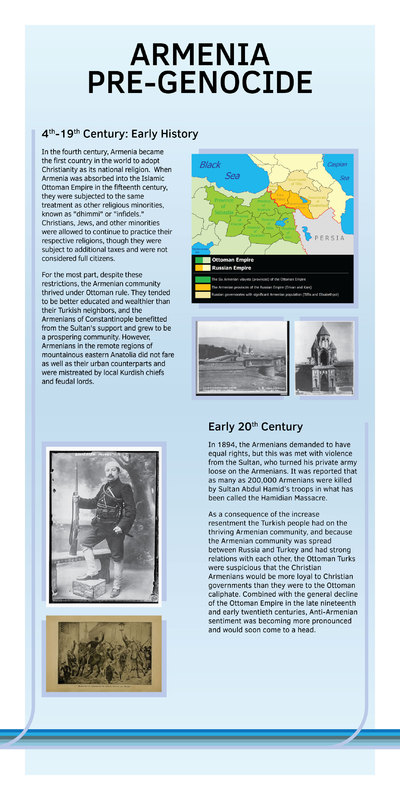Armenia Pre-Genocide 1
4th-19th Century: Early History
In the fourth century, Armenia became the first country in the world to adopt Christianity as its national religion. When Armenia was absorbed into the Islamic Ottoman Empire in the fifteenth century, they were subjected to the same treatment as other religious minorities, known as "dhimmi" or "infidels." Christians, Jews, and other minorities were allowed to continue to practice their respective religions, though they were subject to additional taxes and were not considered full citizens.
For the most part, despite these restrictions, the Armenian community thrived under Ottoman rule. They tended to be better educated and wealthier than their Turkish neighbors, and the Armenians of Constantinople benefitted from the Sultan's support and grew to be a prospering community. However, Armenians in the remote regions of mountainous eastern Anatolia did not fare as well as their urban counterparts and were mistreated by local Kurdish chiefs and feudal lords.
Early 20th Century
In 1894, the Armenians demanded to have equal rights, but this was met with violence from the Sultan, who turned his private army loose on the Armenians. It was reported that as many as 200,000 Armenians were killed by Sultan Abdul Hamid’s troops in what has been called the Hamidian Massacre.
As a consequence of the increase resentment the Turkish people had on the thriving Armenian community, and because the Armenian community was spread between Russia and Turkey and had strong relations with each other, the Ottoman Turks were suspicious that the Christian Armenians would be more loyal to Christian governments than they were to the Ottoman caliphate. Combined with the general decline of the Ottoman Empire in the late nineteenth and early twentieth centuries, Anti-Armenian sentiment was becoming more pronounced and would soon come to a head.
